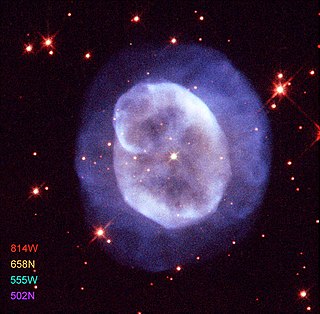
NGC 2346 is a planetary nebula near the celestial equator in the constellation of Monoceros, less than a degree to the ESE of Delta Monocerotis. It is informally known as the Butterfly Nebula. The nebula is bright and conspicuous with a visual magnitude of 9.6, and has been extensively studied. Among its most remarkable characteristics is its unusually cool central star, which is a spectroscopic binary, and its unusual shape.

The Eskimo Nebula, also known as the Clown-faced Nebula, Lion Nebula, or Caldwell 39, is a bipolar double-shell planetary nebula (PN). It was discovered by astronomer William Herschel in 1787. The formation resembles a person's head surrounded by a parka hood. It is surrounded by gas that composed the outer layers of a Sun-like star. The visible inner filaments are ejected by a strong wind of particles from the central star. The outer disk contains unusual, light-year-long filaments.

NGC 40 is a planetary nebula discovered by William Herschel on November 25, 1788, and is composed of hot gas around a dying star. The star has ejected its outer layer which has left behind a small, hot star. Radiation from the star causes the shed outer layer to heat to about 10,000 degrees Celsius and become visible as a planetary nebula. The nebula is about one light-year across. About 30,000 years from now, scientists theorize that NGC 40 will fade away, leaving only a white dwarf star approximately the size of Earth.

NGC 6781 is a planetary nebula located in the equatorial constellation of Aquila, about 2.5° east-northeast of the 5th magnitude star 19 Aquilae. It was discovered July 30, 1788 by the Anglo-German astronomer William Herschel. The nebula lies at a distance of 1,500 ly from the Sun. It has a visual magnitude of 11.4 and spans an angular size of 1.9 × 1.8 arcminutes.

NGC 5307 is a planetary nebula in the southern constellation of Centaurus, positioned less than 3° to the northeast of the star Epsilon Centauri. It was discovered by English astronomer John Herschel on April 15, 1836. The nebula is located at a distance of approximately 10.6 kilolight-years from the Sun. The central star, designated PNG 312.3+10.5, is a weak emission-line star, superficially similar to the WC subtype of Wolf–Rayet stars. It has a spectral class of O(H)3.5 V.

NGC 6578 is a planetary nebula located in Sagittarius. It is magnitude 13.5 with diameter 8 arc seconds. It has a 16th magnitude central star, which is an O-type star with a spectral type of Of. It is seen near the star 16 Sagittarii.

NGC 7662 is a planetary nebula located in the northern constellation Andromeda. It is known as the Blue Snowball Nebula, Snowball Nebula, and Caldwell 22. This nebula was discovered October 6, 1784 by the German-born English astronomer William Herschel. In the New General Catalogue it is described as a "magnificent planetary or annular nebula, very bright, pretty small in angular size, round, blue, variable nucleus". The object has an apparent visual magnitude of 8.3 and spans an angular size of 32″ × 28″. Parallax measurements give a distance estimate of 5,730 ± 340 ly (1,757 ± 103 pc).

NGC 2867 is an elliptical Type II planetary nebula in the southern constellation of Carina, just over a degree to the NNW of the star Iota Carinae. It was discovered by John Herschel on April 1, 1834. Herschel initially thought he might have found a new planet, but on the following night he checked again and discovered it had not moved. The nebula is located at a distance of 7,270 light-years from the Sun.

NGC 2371-2 is a dual lobed planetary nebula located in the constellation Gemini. Visually, it appears like it could be two separate objects; therefore, two entries were given to the planetary nebula by John Louis Emil Dreyer in the New General Catalogue, so it may be referred to as NGC 2371, NGC 2372, or variations on this name. It has also been called the double bubble nebula.

NGC 3242 is a planetary nebula located in the constellation Hydra.

IC 2448 is an elliptical planetary nebula in the constellation of Carina. It was discovered in 1898 by Williamina Fleming. It lies near the bright star Beta Carinae, and the southern Carina can be explored in the months of autumn in the southern hemisphere. The central star of the planetary nebula is an O-type star with a spectral type of O(H)3 III-V. An analysis of Gaia data suggests that it is a binary system.

NGC 1535 is a planetary nebula in the constellation of Eridanus, discovered by William Herschel on February 1, 1785. It is very similar to the Eskimo Nebula in both color and structure but the central star can be quite difficult to observe visually.

Little Ghost Nebula, also known as NGC 6369, is a planetary nebula in the constellation Ophiuchus. It was discovered by William Herschel.

IC 3568 is a planetary nebula that is 1.3 kiloparsecs away from Earth in the constellation of Camelopardalis. It is a relatively young nebula and has a core diameter of only about 0.4 light years. It was dubbed the Lemon Slice Nebula by Jim Kaler, due to its appearance in one false-colour image from the Hubble Space Telescope. The Lemon Slice Nebula is one of the most simple nebulae known, with an almost perfectly spherical morphology. The core of the nebula does not have a distinctly visible structure in formation and is mostly composed of ionized helium. A faint halo of interstellar dust surrounds the nebula. The central star of the planetary nebula is an O-type star with a spectral type of O(H)3.

NGC 6572 is a planetary nebula with magnitude 8.1, easily bright enough to make it an appealing target for amateur astronomers with telescopes. NGC 6572 is a young planetary nebula. NGC 6572 began to shed its gases a few thousand years ago. Because of this, the material is still quite concentrated, which explains its abnormal brightness. The envelope of gas is currently racing out into space at a speed of around 15 kilometres per second. As it becomes more diffuse, it will dim. It is located within the large constellation of Ophiuchus and at low magnification, it will appear to be just a colored star, but higher magnification will reveal its shape. NGC 6572 was discovered in 1825 by the German astronomer Friedrich Georg Wilhelm von Struve. According to several sources such as Sky & Telescope, this object received the nicknames Blue Racquetball, Emerald Nebula, Green Nebula, Turquoise Orb.

IC 1295 is a planetary nebula in the constellation Scutum. It was discovered in 1867 by Truman Safford. It lies roughly 4,700 light-years away.

NGC 7026 is a planetary nebula located 6000 light-years away, in the constellation of Cygnus. The central star of the planetary nebula has a spectral type of [WO3], indicating a spectrum similar to that of an oxygen-rich Wolf–Rayet star. An analysis of Gaia data suggests that it is a binary system.

NGC 1501 is a complex planetary nebula located in the constellation of Camelopardalis, it was discovered on the 27th August 1787 by William Herschel. It is also known as the Oyster Nebula.

NGC 6309, also known as the Box Nebula, is a planetary nebula located in the constellation Ophiuchus. It was discovered by the German astronomer Wilhelm Tempel in 1876. It has a luminosity of about 1800 times that of the Sun. The distance to this nebula is not well known, but it is assumed to be about 6,500 light-years or 2,000 parsecs.

NGC 5979 is a planetary nebula in the constellation Triangulum Australe. It was discovered by John Herschel on April 24, 1835. The central star of the planetary nebula is an O-type star with a spectral type of O(H)3-4.




















